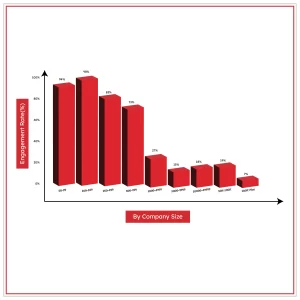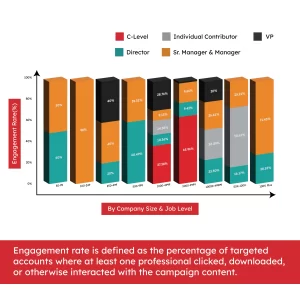In B2B marketing, most companies focus on two extremes: the fast-moving world of startups and small businesses, or the massive, high-value contracts of enterprise giants. While both have their merits, a crucial and often-overlooked segment lies in the middle. This is the realm of mid-sized companies, the powerful engine of the economy and a strategic ‘Goldilocks zone’ for B2B engagement.
What if you could stop wasting time on small deals or getting stuck in corporate bureaucracy? Our data points to a clear answer. For marketers who want great engagement, direct access to leaders, and a genuine shot at building partnerships, all signs are pointing to the mid-market. It’s time to make it the star of your strategy.
Our analysis of 750 B2B campaigns reaching 2.5 million professionals (Marketboats Data 2024) reveals a compelling story. This is our data-backed proof that B2B engagement with mid-sized companies yields superior results. Let’s dive into why marketers are focusing on mid-sized companies in 2025 and why you should, too.
The Data Reveals: Engagement Falls with Company Size
One of the most striking findings from our research is the clear, inverse relationship between company size and overall engagement rate. When we look at how professionals interact with B2B content, a distinct pattern emerges: smaller organizations are significantly more engaged than their larger counterparts.

Figure 1: Engagement rates show a clear inverse correlation with company size. Mid-sized companies (those under 5,000 and especially under 1,000 employees) demonstrate dramatically higher engagement than large enterprises.
The numbers tell a clear story. Companies in the 50-99 and 100-249 employee brackets show engagement rates of 94% and 98%, respectively. This level of interaction remains remarkably high for companies with up to 1,000 employees. For enterprises with over 10,000 employees, the rate plummets to single digits.
Here’s why mid-sized companies deliver outsized results in B2B engagement
Agility and Accessibility: Our analyses highlight that “in small firms, decision-makers are more accessible and nimbler.” Mid-sized companies haven’t yet developed the deep-seated bureaucracy and multiple layers of management that characterize large enterprises. A marketing message is more likely to reach its intended target without being filtered through numerous gatekeepers.
- Focused Challenges: Unlike sprawling enterprises dealing with legacy systems across multiple business units, mid-sized firms often have more focused, well-defined challenges. They are actively seeking solutions to scale, improve efficiency, and gain a competitive edge. This makes them more receptive to targeted, problem-solving content.
- Growth-Oriented Mindset: Mid-sized businesses are in their critical growth phase. They are big enough to invest in robust solutions but still small enough to make decisions quickly. This creates a fertile ground for B2B marketers offering tools and strategies that can fuel their expansion. The mid-market growth potential is an active state of being for these companies.
It’s Not Just How Much Engagement, It’s Who You Engage
High engagement rates are great, but they tell only half the story. The true value lies in who is engaging with your content. A million clicks from interns won’t move the needle, but one click from a CFO can change everything. This is where targeting mid-sized companies in B2B truly shines.
Our analysis of engagement by job level reveals a fundamental difference in B2B buyer behavior in mid-sized firms compared to large enterprises.

Figure 2: In smaller and mid-sized companies, engagement is dominated by senior roles (C-Level, VP, Sr. Manager). In large enterprises, Individual Contributors (ICs) account for the vast majority of engagement.
In companies with fewer than 1,000 employees, a significant portion of engagement comes directly from C-Level executives, VPs, and Senior Managers. For example, in the 250-499 employee bracket, Sr. Managers & Managers and C-Level executives represent a substantial share of the engagement.
Now, contrast this with companies in the 5,000-9,999 or >100K employee range. The chart is dominated by Individual Contributors.
The implication for your mid-market sales enablement and marketing efforts is profound:
- In Mid-Sized Companies: Your content is being consumed by the very people who control budgets and make strategic decisions. The B2B buyer journey in mid-sized companies is shorter because you’re starting the conversation closer to the final decision. You’re not just generating leads, you’re starting strategic conversations.
- In Large Enterprises: Your content primarily engages researchers and influencers. While these Individual Contributors are crucial for building a business case from the ground up, the path to a decision-maker is long and winding. Your sales cycle will inevitably be more complex and protracted.
The appeal of landing an enterprise deal is the massive contract value. But our data shows that for every deal won, countless others get bogged down in bureaucracy and result in immense opportunity cost. The path to that oversized prize is often so risky and resource-intensive that the more predictable, accessible, and strategic partnerships in the mid-market yield a far greater return on effort.
This is a critical distinction between marketing to mid-size businesses vs enterprise. With mid-market companies, you have a direct line to influence, whereas with enterprises, you often have to equip an internal champion to represent you.
The Mid-Market B2B Buyer: A Profile in Pragmatism
Understanding the data is one thing. Understanding the mindset of mid-sized B2B buyers takes it further. These professionals are a unique blend of scrappy entrepreneurship and structured corporate thinking. They are a distinct ideal B2B buyer profile that demands a tailored approach.
What makes mid-market companies ideal B2B customers?
- They Seek Partners: They have graduated from the off-the-shelf solutions that serve small businesses but lack the massive internal teams to implement and manage complex enterprise software. They are looking for B2B partners who can provide not just a product, but also expertise, support, and strategic guidance.
- They are ROI-Driven and Results-Oriented: The mid-market doesn’t have the luxury of speculative tech projects. Every investment must have a clear, demonstrable return. As the research notes, they are “less interested in abstract benefits and more interested in concrete results.” Your marketing must speak the language of ROI, efficiency gains, and measurable outcomes.
- They Balance Strategy with Practicality: The B2B decision-makers in mid-sized companies are often hands-on leaders. A VP of Marketing might still be running campaigns, and a CIO is likely involved in technical implementation. This means your content needs to bridge the strategic and the tactical. Our research found that eBooks were the top-performing content format because they “hit the sweet spot between depth and accessibility,” providing strategic insights for leaders and practical value for their teams.
How to Build Your Winning Mid-Market B2B Engagement Strategy for 2025
Knowing that mid-sized companies are the sweet spot is the first step. Capitalizing on this opportunity requires a deliberate and nuanced strategy. Generic, one-size-fits-all campaigns will fail. Here are the best engagement tactics for mid-sized B2B clients.
1. Ditch Generic Messaging for Hyper-Relevance
Generic campaigns don’t work. Mid-sized buyers are savvy and time-poor. Your content must speak directly to their industry, their size, and their specific growth challenges. A campaign for a 500-person manufacturing firm should look and feel completely different from one for a 500-person SaaS company. This is a core principle of mid-market account based marketing (ABM).
2. Adopt a Multi-Tiered Content Approach
While you have greater access to senior leaders, you will still engage with their teams. An effective B2B marketing for mid-sized companies layers content to serve different needs.
- For C-Levels & VPs: Focus on strategic content that aligns with growth and market leadership. Think high-level eBooks, industry trend reports, and ROI calculators.
- For Directors & Managers: Provide content that helps them build a business case. This includes implementation timelines, competitor comparisons, and case studies from similar-sized companies.
- For Individual Contributors: Offer deep, technical content that answers “how it works.” This includes guides, technical whitepapers, and detailed feature breakdowns.
3. Personalize the Journey, Not the Mere Email
B2B personalization for mid-sized companies goes beyond using [First Name]. It’s about understanding their buying committee and providing a cohesive journey for all stakeholders. Use your data to understand who is engaging and tailor follow-up and nurturing sequences accordingly. If a Director downloads a case study, the next step could be an invitation to a webinar featuring the customer from that case study. If a C-Level executive engages, a personalized outreach from a senior member of your team is warranted.
4. Focus on Building Trust and Demonstrating Value
Mid-sized buyers are making significant investments relative to their revenue, so this trust is a must. How to build trust with mid-sized B2B buyers is a critical question. The answer lies in transparency, consistency, and value. Offer practical advice, share authentic customer stories, and be a resource before you ever ask for a sale. This approach is essential for effective B2B lead generation in the mid-market.
Conclusion: Your B2B Growth Engine is Waiting
B2B marketing pulls you in a million directions. We’re always told to chase the quick wins with small businesses or land that one massive enterprise whale that will make our quarter. But what if the best path forward is the one most people overlook?
The data we’ve shared tells a clear story. The mid-market is where the real action is. It’s where you find engaged leaders who are actively looking for solutions and are ready to build real partnerships. These companies aren’t just another segment to check off your list; they are the sweet spot that can genuinely power your growth.
By taking the time to understand their practical, results-first mindset, you can build relationships that last and create a source of growth that your competitors might be completely missing. So, while everyone else is getting distracted by the noise at the extremes, the smart move is to listen to what the data is telling us. And right now, it’s shouting that the real opportunity is right there in the middle.
If you’re still chasing only the giants, you’ll miss where the real action is. The mid-market should be at the center of your ABM playbook in 2025. Contact us and we’ll help you connect with your right target.
